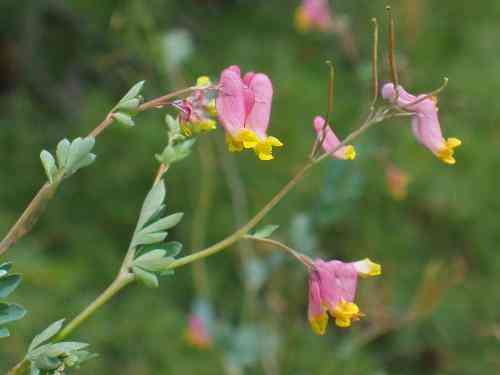Your cart is currently empty!
Veggie Bites – Burdock and Wild Parsnip
Burdock long tap roots haven’t developed the little hair-like roots that anchor them in the ground. I get great joy in pulling noxious weeds.
Your cart is currently empty!
Photo:
Aaron Carlson, CC BY-SA 2.0 via Wikimedia Commons
Corydalis sempervirens is an attractive biennial native to rocky, shallow-soil sites and cooler climates. It is easy to start from seed and has light to dark pink tubular flowers with yellow tips and greenish-blue leaves. Being a biennial, it will have basal rosettes at ground level the first year and flowering plants the second year. It could fill in any bare spot in a sun or semi-shade garden quite quickly.
Pale Corydalis can be propagated through division and seeding and does best in dry, sunny to partly sunny areas of slopes, woodland edges, rocky or sandy soils, but where the air temperature is not overly hot, as this is a plant for cooler environments.
Botanical Name: Corydalis sempervirens
En français: Corydale toujours-verte
Blooms:
Sun / Shade:
Water: Average Water Needs; Water regularly; do not overwater
Soil:
Height:
Pollinators:

Its natural habitat consists of dry rocky deciduous woods and borders. It is most common in the New England states, the Great Lakes region, and south along the Blue Ridge Mountains into northwestern Georgia. It is widespread in Canada and can also be found in Alaska. Companion plant suggestions many spring ephermals, including Raspberry Splash Lungwort, Dutchman’s breeches, Trilliums, Trout Lilies, and Bloodroot.
Burdock long tap roots haven’t developed the little hair-like roots that anchor them in the ground. I get great joy in pulling noxious weeds.
Learn how to care for your Preston Lilac. Tips on planting, soil, watering, pruning, and more for a thriving garden addition.
Horseradish is exceptionally easy to grow, highly productive, and has a lot of other uses beyond making wasabi, and can clear sinuses.
The Christmas Fern got its name because it flowers in winter and stays green throughout the holidays. We discuss care for Chirstmas Fern
Learn how to create a natural white oil insecticide at home with this simple DIY recipe for effective organic pest control.
I enjoy every bird as it is taken out of the bag. It feels a little bit like Christmas each time the bander, professionally takes a bird out for processing. We revel in the beauty of an American Redstart or the grand beak of a Northern Flicker.
GardeningCalendar.ca gets some funding from advertisers. If you click on links and advertisements at no cost to you, the site may receive a small commission that helps fund its operation.
© 2025 J&S Calendars Ltd.
Leave a Reply